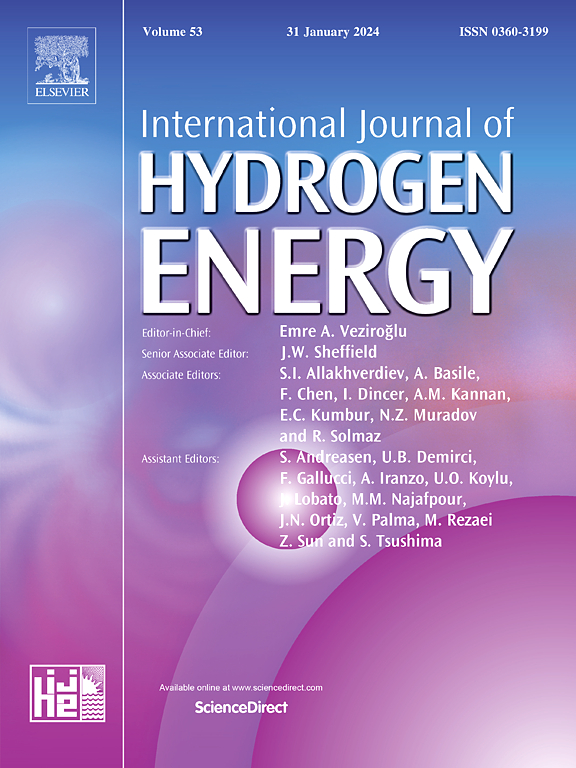塑料废弃物热解合成气制氢研究进展与挑战
IF 8.1
2区 工程技术
Q1 CHEMISTRY, PHYSICAL
引用次数: 0
摘要
全球每年生产3.8亿吨塑料,其中75%以上的塑料作为废物被丢弃在环境中。塑料废物的日益积累构成了重大的环境和健康风险,迫切需要制定可持续的废物管理战略。一个有希望的解决方案是通过热化学过程,如热解/气化,将塑料废物转化为有价值的能源产品(油、炭和合成气)。本文综述了塑料废弃物热解合成气制氢的研究进展。PET和HDPE是高效的原料,在热解过程中分别产生高达77%和66%的气体产率。研究人员青睐热解,因为它能够从塑料废物中产生35%到40%的合成气,这取决于所使用的热解过程的类型。本文综述了热解关键工艺参数(温度、压力、停留时间、升温速率、催化剂和原料组成)对产氢率和产氢质量的影响。热解,特别是使用不同类型的催化剂,将氢产量提高到219 mmol/g至730.6 mmol/g。讨论了钯基膜在从合成气中高效分离氢气,纯度达到99.99%方面的作用。在钯基膜中,PdAg对杂质、二氧化碳(co2)、一氧化碳(CO)、甲烷(ch4)等具有良好的抑制作用,对降低膜厚度、耐久性、质量、稳定性和选择性的有毒物质(硫和氯)具有良好的抑制作用。450℃时,钯银膜的渗透率最高为3.2 × 10−8 mol. m−1.s−1.pa−0.5,膜厚最低为0.8 μm。与填埋、焚烧和回收等传统方法相比,塑料垃圾热解产生的二氧化碳(1-3 kg CO2/kg H2)排放量显著降低。该报告总结了未来研究方向的路线图,旨在优化塑料废物合成气中的氢分离,为塑料废物管理和清洁能源生产开发具有成本效益的可持续解决方案,从而为更清洁的环境和可持续的能源未来做出贡献。本文章由计算机程序翻译,如有差异,请以英文原文为准。
Hydrogen production from plastic waste pyrolysis syngas: A review on progresses and challenges
Globally, 380 million tons of plastic are produced annually, and more than 75 % of these plastics are rejected as waste in the environment. The increasing accumulation of plastic waste poses significant environmental, and health risks and urges the need for sustainable waste management strategies. One promising solution is the conversion of plastic waste into valuable energy products (oil, char, and syngas) through thermochemical processes, such as pyrolysis/gasification. This review focuses on hydrogen production from syngas derived from the pyrolysis of plastic waste. PET and HDPE emerge as highly effective feedstocks, producing gaseous yields of up to 77 % and 66 %, respectively, during pyrolysis. Researchers favour pyrolysis because of its ability to yield syngas from 35 % to 40 % from plastic waste, depending on the type of pyrolysis process used. This review evaluates the impact of key pyrolysis process parameters (temperature, pressure, residence time, heating rate, catalyst, and feedstock composition) on hydrogen yield and its quality. Pyrolysis, particularly using different types of catalysts, increases hydrogen output to as high as 219 mmol/g to 730.6 mmol/g. Advances on palladium-based membranes have been discussed for their role in separating hydrogen from syngas efficiently, achieving 99.99 % purity. Among palladium-based membranes, performance of PdAg is reviewed in detail as it shows good effectiveness against impurities, carbon dioxides (C , carbon monoxide (CO), methane (C , etc. and efficiency against poisoning (sulphur and Chlorine) that reduce the membrane thickness, durability, quality, stability and selectivity. The highest permeability of palladium silver (PdAg) membrane was found 3.2 × mol. at 450 °C and the lowest thickness was found 0.8 μm. Plastic waste pyrolysis produces significantly lower C (1–3 kg C/kg ) emissions compared to traditional methods such as landfilling, incineration and recycling. The review concludes with a roadmap for future research directions aimed at optimising hydrogen separation from plastic waste syngas to develop cost-effective, sustainable solutions for plastic waste management and clean energy production, thereby contributing to a cleaner environment and sustainable energy future.
求助全文
通过发布文献求助,成功后即可免费获取论文全文。
去求助
来源期刊

International Journal of Hydrogen Energy
工程技术-环境科学
CiteScore
13.50
自引率
25.00%
发文量
3502
审稿时长
60 days
期刊介绍:
The objective of the International Journal of Hydrogen Energy is to facilitate the exchange of new ideas, technological advancements, and research findings in the field of Hydrogen Energy among scientists and engineers worldwide. This journal showcases original research, both analytical and experimental, covering various aspects of Hydrogen Energy. These include production, storage, transmission, utilization, enabling technologies, environmental impact, economic considerations, and global perspectives on hydrogen and its carriers such as NH3, CH4, alcohols, etc.
The utilization aspect encompasses various methods such as thermochemical (combustion), photochemical, electrochemical (fuel cells), and nuclear conversion of hydrogen, hydrogen isotopes, and hydrogen carriers into thermal, mechanical, and electrical energies. The applications of these energies can be found in transportation (including aerospace), industrial, commercial, and residential sectors.
 求助内容:
求助内容: 应助结果提醒方式:
应助结果提醒方式:


